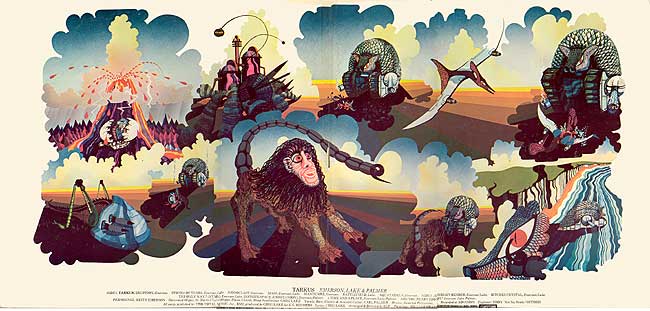If the images above do not immediately register and make you laugh (or at least cringe), you must not be properly acquainted with ELP in general and Tarkus in particular. Fear not, read on and all will be revealed.
Emerson Lake & Palmer (ELP), to their credit, cannot be pigeonholed. They were by far the most audacious—and, to haters, most pretentious—prog rockers, usurping sacred texts like Pictures at an Exhibition (a sample can be celebrated, or vitiated here). Never mind that they exposed this work to young fans who otherwise wouldn’t know Modest Mussorgsky from Modest Mouse. On the other hand, their decision to cover Tchaikovsky’s Nutcracker and re-title it Nutrocker must have elicited the same type of scorn consumers felt when Burger King introduced the Croissandwich, in the ‘80s.
The band also had a less refined side they could not, or would not suppress, and more power to them. Accused, sometimes fairly, of taking themselves too seriously, they nevertheless wasted space on almost every album with throwaway larks like “Benny the Bouncer”, “Jeremy Bender” and “The Sheriff”. It was almost as though, after tackling (or mauling, depending upon one’s perspective) celebrated and more obscure classical pieces, or else compiling multi-part song suites, they needed to blow off some steam. It may be correct to conclude ELP was a band that was capable of being too overbearing and too cavalier, which means, at the end of the day, they are incapable of being dismissed as one-trick ponies.
The most important fact is that, like most of their proggy brethren, when they were on, they were egos-be-damn-the-torpedoes awesome. There are many moments, on both of these albums that don’t merely survive the stones of years, but still sound miles ahead—in terms of musical proficiency, conception and execution—of what just about any other band is capable of achieving.
Their self-titled debut was not an introduction so much as a kind of coronation: We are geniuses, hear us roar! The ideas and styles crammed into these six songs are at once staggering and overpowering, yet they manage to pull it off so that it never seems superfluous or overwrought (that problem would surface later on in their career). Even by the no-holds-barred sensibility of progressive rock, circa 1970, no other band would—or could—have come out of the gate deconstructing an all but unknown composition (“Allegro Barbaro”) by an all but unknown, to young rock fans anyway, maestro (Béla Bartók). “The Barbarian” can scarcely contain itself, from the opening grunge-fuzz effects to the bass throbs and hyper-kinetic drums (the only drummer half as busy as Carl Palmer was Mitch Mitchell who, coincidentally, auditioned unsuccessfully for the gig). After the initial chaos subsides, Keith Emerson switches from organ to piano and gives the first of many clinics. He is not aping classical music, he is appropriating it, subverting it, celebrating it.
The centerpiece, and masterpiece, is Greg Lake’s twelve-and-a-half minute “Take A Pebble” which, as well as any song from the era, epitomizes the all-in ethos these bands were running up the flag pole. Plucked piano strings, plaintive acoustic strumming, showers of cymbals, a countrified interlude complete with hand claps (that you can almost dance to) and an extended piano-led excursion that stands alongside any progressive music ever made. The next three songs balance the sorts of extremes that became the band’s calling card: Emerson’s church organ, solo piano and piano trio explorations on “The Three Fates”, Palmer’s drum solo showcase “Tank” and the obligatory social commentary soundtrack of the apocalypse “Knife Edge”. And finally the album concludes with “Lucky Man”, which sounds as unimprovable as ever, Lake demonstrating that his pipes were as golden as any other young god’s during the early ‘70s.
Those vocals and all the other glorious sounds are presented, better than ever before, on these Deluxe Editions. As he has done in recent years for King Crimson and Jethro Tull, Porcupine Tree’s Steven Wilson holed himself up in the studio and painstakingly remastered, remixed and reproduced these seminal recordings. Anyone who has heard the results from his previous work in this arena will understand, at once, that he has become progressive rock’s MVP, willing to lift dusty, discarded tapes to restore and refine them. The results, predictably, are remarkable, and whether you’d like the familiar versions made slightly better, or are keen to enjoy slightly remixed versions, or want to see how these chestnuts translate in 5.1 Surround Sound, these are the discs you’ve been praying for. We’ll see if Wilson is asked to do similar work for other ELP gems, or if he’ll be too preoccupied diving into other groups’ back catalogs.
The Clash’s Paul Simonon, spewing venom shared by virtually all punks in the late ‘70s, once stated that all he had to do was look at a Led Zeppelin album cover and he felt like vomiting. Presumably, he never saw the cover of Tarkus or he may have been obliged to poke his eyes out with a rusted clothespin. There is simply no getting around how terrible this album art is, and by terrible, some of us might also mean amazing. To paraphrase another (fake) rock icon, Spinal Tap’s Nigel Tufnel: “It’s like, how much more prog could this be? And the answer is none. None more prog.” Indeed, it was on their second album that ELP went to “eleven”, forever separating enthusiasts from skeptics.
Tarkus is, structurally, the obverse of another fatally flawed, would-be masterwork, Love’s Da Capo. Where Love blazed the hazy trail of the side-long cut which would eventually be an obligatory element of prog rock albums, their 19-minute opus “Revelation” is widely considered atrocious, marring an otherwise perfect album. On the other hand, the 20-minute “Tarkus” suite endures as a particularly inspired prog epic, while the individual tracks on the other side are aged and mostly forgettable. Actually, in fairness, there is a fantastic one-two punch courtesy of “The Only Way (Hymn)” and “Infinite Space (Conclusion)” that was, and remains, a total triumph. In terms of its plainspoken assault on inculcated religious faith, “The Only Way” is, lyrically, a considerably less articulate, but still quite satisfying companion piece to Jethro Tull’s “My God” (from Aqualung) which would also appear in 1971. Just as Tull employs a mock hymn (with multi-tracked chanting), Emerson utilizes his organ (modeled on Bach’s “Toccata in F major) to mimic a church service and, naturally, his playing was recorded in a church.
If the remaining songs are less than memorable, the same cannot be said of the title track. “Tarkus” is where grandiosity meets pomposity and, so, there is a volcanic eruption and the beast/machine (part tank, part armadillo) hatches from an egg and does battle with the Manticore, which is part human and…well, yeah. Like their close cousins in Yes, ELP’s lyrics usually ranged from impenetrable to laughable (while occasionally reaching the heights of sophomoric). But as is typically the case with prog rock (and, ahem, opera for that matter), the words are all but immaterial; it’s about the music and the mood. The martial Sturm und Drang of the opening notes (signaling the aforementioned eruption) billowing into the scorched earth lamentation of “Stones of Years” balances intensity and release with inimitable aplomb. It contains multitudes, and they will mean different things to different people, but it’s hard to deny the good, bad and ugly that runneth over like blood turned to wine or lava…turning into Tarkus.
Herein lies what Colonel Kurtz called “the horror” and what recalcitrant enthusiasts (or idiots) like this writer call…the horror! (But in a good way.) Some prog-rock bands (like Rush) had a penchant for re-imagining or reinterpreting classical literary legends like Apollo and Dionysus while others (like Rush) would create their own mythical heroes (By Tor, Snow Dog, etc.). Looking at this cover art, and seeing song titles like “Battlefield”, “Manticore” and “Aquatarkus” (not to be confused with “Aqualung”), some music fans ask for the check, understandably. Here’s the thing, though: all the armadillo tank drawings and semi-preposterous titles—and lyrics—are just window dressing for the artistry that occurs once these well medicated, undeniably brilliant musicians throw down. And throw down they do, in ways that make myopic pinheads lament how a man with unparalleled keyboard skill—like Keith Emerson’s—might have made so much better use of his talents had he dedicated his life to playing Chopin recitals in sparsely attended concert halls. He made a different kind of music and, in the process, he and his mates made history.


